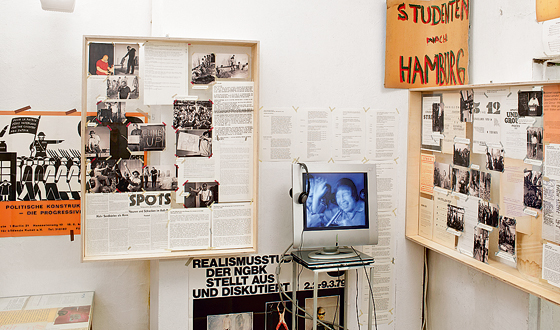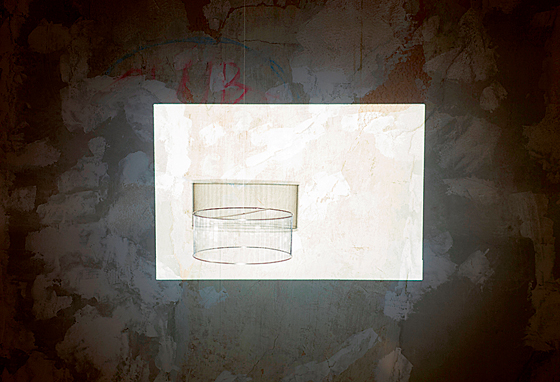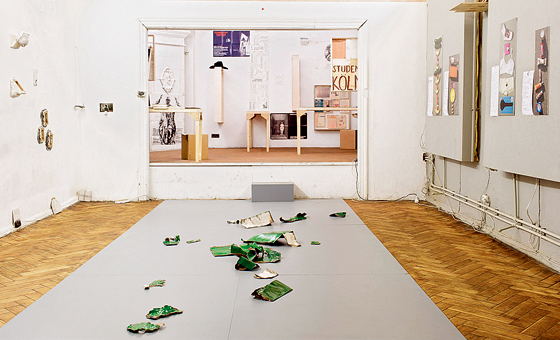|
|
| The bearable lightness of art Maija Rudovska, Art Critic, Curator Berlin–Riga. Scores for Indeterminate Places 11.04.–08.05.2013. Kaņepe Culture Centre | |
| In a recent issue of eflux (No. 42, 2013) there was an article by cura- tor and philosopher Dieter Roelstraete, “The Busyness: On the Un- bearable Lightness of Art”. In it, he described the “busyness” in the contemporary art world and pointed out that artists have no time to create art, critics – to write about art, and curators – to organise art exhibitions. What, then, is keeping us busy? Networking, constantly getting in touch, socializing, emailing, tweeting, facebooking, writ- ing applications for funds and planning. Probably it can be stated with certainty that nothing takes place these days without the right people and the right places, which is why this busyness occurs. One of the “right” places in this respect is Berlin. It is not only a place where one can seek happiness, “take a breath of fresh air” and live more cheaply than in Riga, but it is also a place where to further an artist’s / curator’s career, providing the opportunity to get to know Western praxis, mingle with their discourses and continue by finding the contexts and forms that one needs. | |
 Valdis Āboliņš, Kristīne Alksne. Scores. Installation. 2013 Photo: Andrejs Strokins Publicity photos Courtesy of the artists | |
| The route Berlin-Riga-Berlin The exhibition Berlin–Riga. Scores for Indeterminate Places which was organised by the Centre for Contemporary Art (curators – Ieva Astahovska and Antra Priede), was to some degree an homage to the significance of Berlin in the annals of local – Latvian – history of art. Already for a considerable period of time the Latvian Centre for Con- temporary Art has been intentionally focusing on the art and cultural phenomena of the Soviet era in Latvia, raising awareness of it, re viewing it and rewriting its history. This time, the point of departure was the contact that was established with Berlin at the end of the 1970s and at the beginning of the 1980s, thanks to an artist of Latvian origin and an active member of Fluxus(1), Valdis Āboliņš (1939–1984). He was the main personality at the exhibition, welcoming visitors in the lobby in the guise of the popular painting Valda Āboliņa portrets (‘Portrait of Valdis Āboliņš’, 1979) by Maija Tabaka. The black, eye catching hat that Āboliņš used to wear had become a fellowtraveller at the exhibition, almost making one think that Āboliņš himself had participated in organising this event. It must be said, however, that the exhibition did not cover the art phenomena of the time, or to put it more accurately – they were not exhibited, instead the choice had been made to present an interaction with contemporary artists. Latvian art history has a tendency to take pride in contacts that have been established with the West, especially if it happened during Soviet times, when any breezes from the West could become signifi- cant points of reference in Latvian art and culture. But given that we are still struggling to get to know and understand our history, re writing it and revising attitudes, then it is possible to state that pur- suing recognition or at least kindness from other centres (here I’m also implying an uncritical acceptance of this model in the texts of art history) continues to be an obstacle. Clearly, during Soviet times Western trends were something special and seemingly genuine (as opposed to socialist realism), and, in less powerful and confused societies in quest of their identity, the influences of leading discourses were usually received with excitement. And Latvian art was no exception. To my mind, this was also the case when, due to Āboliņš, a closer connection with Western practices was established. He, of course, is not the only one, but perhaps he is one of the more vivid examples. | |
 Ulrihs Fogls. Ulrich Vogl. 4 a.m. Installation. 2013 Photo: Andrejs Strokins Publicity photos Courtesy of the artist | |
| Inheritance or playing around? Despite that the name of Āboliņš had taken on something like the role of patron, the exhibition was not very eloquent about his activities in Aachen, Berlin and elsewhere in Germany, or about his particular “feel” for art, or Fluxus events in which he took part and which he organised. Nor did the exhibition tell us much about the way contacts were established with the art scene in Soviet Latvia (the tiny archive corner arranged by Kristīne Alksne and entitled Partitūras (‘Scores’, 2013) by its nature acted more as visual rather than informative ma- terial). Most likely that was not the aim of the project, however it should be remarked immediately: a less informed viewer would not guess that it was precisely with the support of Āboliņš that painter Maija Tabaka had the unique opportunity to spend some time in residence in Berlin at the end of the 1970s. At the time, something like that was a rare occurrence. Those in the know may have been reminded of this small episode by Tabaka’s painting at the entrance of the exhibition, but there are many other episodes about which one would have liked to have been enlightened in depth and a more de- tailed context. As indicated by the curators, this will be covered in a publication that is due to come out some time. Although the exhibition had been mounted taking inspiration from the Fluxus movement and its principles of operation, the curators had rather chosen to emphasise the principle of connection and “atmosphere”, as opposed to accentuating direct influences. The analogy with “scores” was chosen as a means of expression that by definition would have to convey a message about following a certain system, yet, the reference to “open scores” that, according to the curators, were also used by Fluxus artists, in the framework of the exhibition indicated an aggregate of accidents and their combinations, including small gestures, playful manoeuvres, comments, absurd situations, additions, fragments, exclamations, etc. The exhibition was focused on contemporary art, spatially and temporally juxtaposed with archive materials and memories about Berlin. Possibly the establishment of this contact was the story of its success – contemporary artists became background figures as opposed to central players, reviving and creating a spatial dialogue without a temporal dimension. Can it be termed the implementation or continuation of a tradition, similarly as has happened in Lithuania, when contempo- rary art, especially under the wing of the Contemporary Art Centre (CAC), established a close relationship with the oeuvre of George Maciunas and other representatives of Fluxus? Most likely not, however, it is a poetical way of creating continuation and not to lose continuity with a part of history significant to the local culture. The list of artists included in the exhibition does, however, give rise to questions and doubts about the selection criteria. If the goal of the curators was to emphasize the connection with Berlin with the help of these artists, it has not been much of a success, unless the occasional parties and residencies there are taken into account. As a matter of fact, over the last decade, ever since Berlin has been declared to be one of the most dynamic art centres, all the twenty somethings have been going there. But the question arises: why didn’t they choose artists (and curators) who have been living in this city for several years (for example, Linards Kulless, Margo, Atis Jākobsons, Kaspars Vanags and others), who have bonded with it and would have been able to reflect about this connection more powerfully? Apparently, some other reason served as the basis for the selection of artists, perhaps their skills and interest in playing, abstraction, combinations, speaking ironically or incorporating other elements that characterise the Fluxus movement or resemble it. As it is known, none of them is following in the footsteps of Fluxus directly, therefore the works of art in the context of the exhibition have become a commentary, not a continuation. Be that as it may, a spirit of lightheartedness and amusement was present at the exhibition, especially when the team consisted of such artists as Ivars Grāvlejs, Romans Korovins, Maija Kurševa and others. In my opinion, the most successful embodiment of the playing with life, the presence of the absurd and antiart in the best Fluxus traditions was in the dark room at the end of the exhibition, where a joint work Sagrozītie fakti (‘Distorted Facts’, 2013) by Maija Kurševa and Edgars Jurjāns was on show. Ghostly figures and objects tangling underfoot, voices which could be recognised as belonging to wellknown announcers from Latvijas Radio and a gruesome portrait of artist Jānis Filipovičs made one wish to linger and enjoy this incomprehensible poetry. | |
 Benjamin Greber. Dolores Lavatorium. Installation. 2012 Photo: Andrejs Strokins Publicity photos Courtesy of the artist | |
| The bearable lightness of art Following Roelstraete’s idea that “lightness of touch, lightness of materials, lightness of exhibiting, lightness of conception”,(2) is characteristic of contemporary art, I would like to say the same for the exhibition Berlin–Riga. Scores of Indeterminate Places. Lightness in the sense that the works of art played, literally grew together with the walls, merged with each other and grew into each other, creating a sort of a hustle and bustle and chatting that in general could be en- joyed as an aesthetic that does not require any special concentration. We could also speak of lightness as a contemporary trend in visual language: often the use of found and used objects, combinations, a small scale, arrangements of various elements, fragile and dispos- able materials, etc.; all of it together leaves a sense of incompleteness, like a sketch, a draft, a moment or a process. Something must also be said about the venue – Kaņepe Culture Centre, where the exhibition took place. Such an extensive exhibition was held at these premises for the first time. The fact that Riga has become one exhibition hall richer is, of course, laudable, but it also became apparent that the unreadiness of the space in this case was more harmful than helpful. The works of art exhibited, and the light- ness and fragility already mentioned, required intimacy and diligent looking, and more space – both literally and metaphorically, where they could expand and highlight their message without losing connection with the general concept. Unfortunately, in these premises and in this situation some of the works seemed lost or stifled. However, in general the exhibition was able to offer very multifaceted and exciting material, unusual combinations and surprises. Hopefully it will serve as a springboard for further reflexions on the subject in the future. Also, a detailed study about Valdis Āboliņš and his influence is currently a topical issue in the writing of local art history, and let’s hope that we won’t have to wait too long for it. Translation into English: Laine Kristberga 1 Fluxus – art movement with the main initiator and founder in the person of artist George Maciunas, originally from Lithuania. It was expressed not as a movement, but rather as a phenomenon that acquired international character. Fluxus had a close connection with avant-garde music and John Cage, however the artists involved have sought to avoid any definitions or categories in which this phenomenon could be framed. The objective of Fluxus was to break down the margins between life and art, artist and audience, a work of art and an object, that is why Maciunas called it anti-art. According to him, Fluxus “should be about insignificant things, it shouldn’t require special skills and countless rehearsals, it should have no commercial or institutional value” (Ruhrberg, Karl. Honnef, Klaus. Scgneckenburger, Manfred. Fricke, Christiane. Art of the 20th Century. Part 1. Köln: Taschen, 2000, p. 585). 2 e-flux, 2013, No 42. | |
| go back | |







